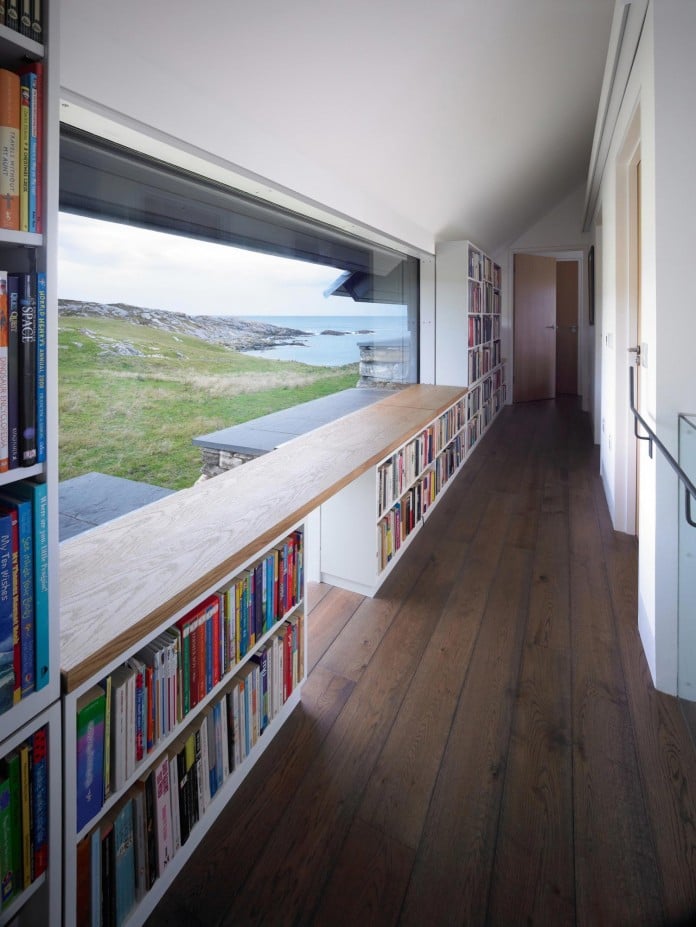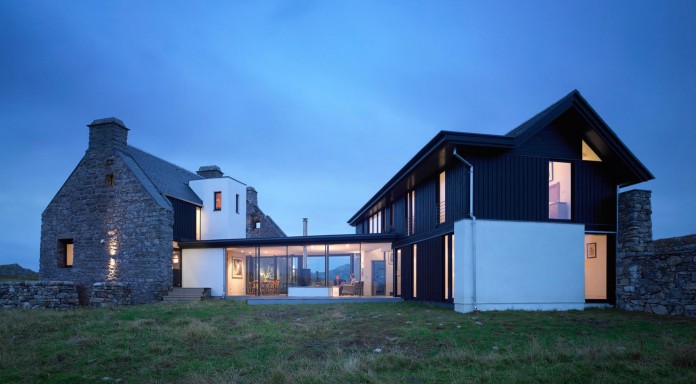The White House by WT Architecture
Architects: WT Architecture
Location: Grishipoll, Isle of Coll, Scotland
Year: 2011
Area: 3,229 sqft /300 sqm
Photo courtesy: Andrew Lee
Description:
The original house at Grishipol (rough bay) on the archipelago island of Coll was in-built the middle 1700’s by Maclean of Coll for his Tac man, or Factor. it had been the primary lime-built square-cornered house on the island and took on the informal name ‘The White House’ characteristic it from the essential ‘black houses’ that were the norm on the island. In 1773 Boswell and J. E. Johnston were diverted there while confined throughout their notable tour of European country. except for all its grandeur the White House had been designed on sand and was deserted within the middle 1800’s because it began to crack.
When Alex and Seonaid Maclean-Bristol transmissible the building some150 years later a number of the cracks within the roofless ruin were quite a foot wide however the essential structure remained miraculously intact. Alex was spoken on Coll and came to farm on the island with adult female Seonaid once disbursement some years away within the army. They were keen to make a house for his or her new family on the positioning however the character of the ruin conferred a drag. ought to they restore it or build a replacement house nearby? it had been at this time that we tend to advised that neither of those approaches ought to be taken which the essential ruined nature of the structure was what gave it abundant of its magic. that the plan of partial occupation of the ruin was explored with the intention that alternative new accommodation would be visually separate however physically connected to the ruin.
The original house was picturesquely sited with a commanding presence over the fertile vale resulting in Grishipol Bay. Fingers of stone walls extended from the ruin forming garden-like enclosures and this junction rectifier to responsive branch of knowledge forms for the new house wherever original broken-down walls were designed up and new enclosures created to make shelter and against that new accommodation might nestle. This preserved the tooth-like nature of the first building while breaking down the massing of the new structures and ensured that they remained subservient to the first building. nearly half the first house would stay roofless and become a court garden, protective the plucky charm of the ruin.
Consolidation of the structure provided a challenge given the scale of the cracks and a system of exposed chrome steel ties and bracing frames in original window and fireplaces openings was devised with project engineers David Narro Associates. There was no economic means that of closing the most cracks up and it had been additionally felt that they contributed such a lot to the identity of the house that they ought to be preserved and increased wherever doable. The consolidation work was rigorously undertaken by native island builder Tom Davies and took nearly a year up to the purpose once the most construction contract started.
Sadly none of the island builders were large enough to require on the most construction section of the build, thus finding the correct contractor junction rectifier to a Scotland-wide search, with Kinghussie based mostly Spey Building and Joinery with success winning the contract. This alternative couldn’t are additional prosperous with SBJ transfer all the ability and ingenuity of true Highlanders to the project. Remote operating junction rectifier them to control a 2 week on/one week off schedule to the task. With solely 3 ferries every week in winter immaculate designing was required, however the weather and also the idiosyncrasies of the ferry service will typically challenge the simplest set plans. The remoteness of the positioning junction rectifier to the bizarre state of affairs of accommodation and line being provided by the shoppers, UN agency were living in an exceedingly close house throughout the build. this might have caused all kinds of stresses and strains however the positive angle of each shoppers and builders alike meant this consolidated the team and helped guarantee a sleek and happy build.
A three story high antechamber and staircase was created within the main ruin, with half the ruin left as a roofless court, following stabilisation and consolidation of the walls. A room and main bedroom occupy the rest of the first building with a tooth-like stack of stores, larder, WC, room and study at its core, all connected with a glass and steel support.
To the rear of the first building new areas living and bedchamber areas stretch out munificently into the landscape with expanses of glazing to suck within the beautiful landscape and ocean views. The new structures shelter between the new thick dry stone enclosure walls that develop on and extend an inventive lattice of enclosure walls round the house. AN H-shaped set up provides pockets of external shelter on the terribly exposed website. The new stone walls recycle dust from the positioning and foreign mixture and masonry were unbroken to a minimum to cut back transportation and environmental prices.
The building is heated through a device which can be supercharged by a presently to be erected turbine, which means that on mixture power are going to be exported.
The main hall within the ruin connects through to a living-dining area with glazed walls and a sedum-covered roof, the herbaceous plant reechoing the natural flora on the positioning. Slate paving stretches from the lounge within dead set a south-facing court on one aspect and a seaward facing terrace on the opposite. A wing of latest rooms to the west provides four more bedrooms, utility areas, and a panelled cosy house, that is separated from the most lounge by a wall of shelves. Stairs wrap around this cosy house up to a book-lined landing wherever an extended bench appearance out over the large sheltering west wall and right down to Alex’s boat mooring.
Big open rooms ar contrasted with smaller snugs and nooks and crannies for individual retreat that the house offers each expansive and intimate moments. In spite of its high style ambitions it remains hard-wearing family house. youngsters bash their toys into the walls and Highland cows peer at their reflections in frameless glass walls. it’s a house supposed to measure up to the character of the ruin of the White House and to interact with and heighten the expertise of living in a fantastic place.
Thank you for reading this article!



















